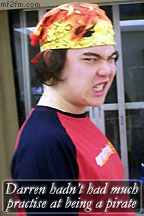 Back in 2008, Wireless Waffle discussed the fact that the licensing of new community radio stations by Ofcom had forced many pirate radio stations to change frequency and in some cases to move to using two (or more) frequencies simultaneously in order to provide wide area coverage without treading on the toes of officially licensed stations.
Back in 2008, Wireless Waffle discussed the fact that the licensing of new community radio stations by Ofcom had forced many pirate radio stations to change frequency and in some cases to move to using two (or more) frequencies simultaneously in order to provide wide area coverage without treading on the toes of officially licensed stations. As the number of community stations continues to grow, the problem of finding a 'clear' frequency for the pirates to operate on becomes increasingly difficult. Indeed, one might even go so far as to suggest that part of the reason for Ofcom's relatively newly found interest in licensing community radio stations is to purposefully force pirates off the airwaves, which would, of course, be in perfect alignment with their objectives as the regulator of the radio spectrum.
For many years Ofcom claimed that there were no FM frequencies available for new radio stations as the band was full, but over the past 10 years or so, they have licensed dozens of community stations all over the country. Being lower power and covering a smaller area they have managed to squeeze a number of stations into a band which had been previously claimed to have no space in it. What is interesting is how similar the frequencies chosen by Ofcom for the community stations are to those that were previously employed by the pirates themselves, suggesting that the frequencies that the pirates were using were well chosen so as to try and avoid causing interference to legitimate stations.
Take, for example, the handful of radio pirates operating in Brighton on the south coast of the UK. The table below shows some of the frequencies used by pirates in the area, and the frequencies used by the four community stations now broadcasting to the city. You will note that there is a large degree of commonality.
| Pirate Station | Frequency | Community Station | Frequency |
|---|---|---|---|
| InFront FM Haven976 | 97.9 97.6 | Gaydio | 97.8 |
| Radio 4A | 101.4 | 1BTN | 101.4 |
| CodeSouth FM | 105.6 | Platform B | 105.5 |
| - | - | Radio Reverb | 97.2 |
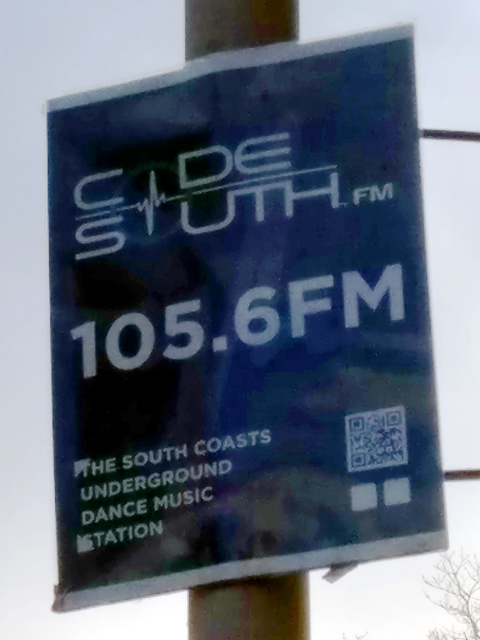 One station, CodeSouth, has changed frequency four times since it first went on air in 2012. Initialy on 108.0, it moved to 88.8 in 2013, then to 98.5 (the frequency previously used by another Brighton pirate 'FIP') from 2014 to 2015, then to 105.6 until late 2018 and is currently on 88.2 MHz. Incidentally, the choice of 88.2 MHz may not be the best, as it is the frequency used by a low-power relay of BBC Radio 2 in nearby Bexhill. Though the relay does not put a strong signal into Brighton and thus the frequency may appear empty, the same may not be true of CodeSouth's big signal heading in the opposite direction (88.0 may have been a better choice). Of course there are a decreasing number of frequencies available and any choice is likely to cause potential interference to someone.
One station, CodeSouth, has changed frequency four times since it first went on air in 2012. Initialy on 108.0, it moved to 88.8 in 2013, then to 98.5 (the frequency previously used by another Brighton pirate 'FIP') from 2014 to 2015, then to 105.6 until late 2018 and is currently on 88.2 MHz. Incidentally, the choice of 88.2 MHz may not be the best, as it is the frequency used by a low-power relay of BBC Radio 2 in nearby Bexhill. Though the relay does not put a strong signal into Brighton and thus the frequency may appear empty, the same may not be true of CodeSouth's big signal heading in the opposite direction (88.0 may have been a better choice). Of course there are a decreasing number of frequencies available and any choice is likely to cause potential interference to someone. The other pirate stations have not been heard of for some time. It seems at least partially feasible that some of the presenters have found their way onto one of the new community stations and as such there is no longer a need for them to fly the jolly radio roger. In this respect, it could be argued that Ofcom's community radio policy has had a double whammy effect and both taken away the frequencies from the pirates, and taken away the needs of the DJ's to use pirate stations as an outlet for their music.
 Despite all the above, the simplicity of Internet streaming (which many of the pirates also do) and the opportunity of space on local DAB multiplexes, the UK's licensing laws must still be failing some part of the musical community, otherwise there would no longer be a need for the pirates. The whole situation sounds hugely reminiscent of the very early days of the pirates, when the BBC launched Radio 1 to try and take away the need for the offshore stations playing 'pop' music, yet the pirates persevered. What will it take to finally find a way to end unlicensed broadcasting, and give everyone who wishes to have a radio show the audience they seek?
Despite all the above, the simplicity of Internet streaming (which many of the pirates also do) and the opportunity of space on local DAB multiplexes, the UK's licensing laws must still be failing some part of the musical community, otherwise there would no longer be a need for the pirates. The whole situation sounds hugely reminiscent of the very early days of the pirates, when the BBC launched Radio 1 to try and take away the need for the offshore stations playing 'pop' music, yet the pirates persevered. What will it take to finally find a way to end unlicensed broadcasting, and give everyone who wishes to have a radio show the audience they seek?add comment
( 1183 views )
| permalink
| 



 ( 3 / 91506 )
( 3 / 91506 )




 ( 3 / 91506 )
( 3 / 91506 )
Wednesday 22 November, 2017, 15:31 - Broadcasting, Licensed, Pirate/Clandestine
Posted by Administrator
Posted by Administrator
 Wireless Waffle previously sang the praises of the boat trips to visit the Ross Revenge, the home of former radio pirate, Radio Caroline. We also noted that they had been awarded a licence to operate a 1 kiloWatt transmitter on 648 kHz in the Suffolk and north Essex area.
Wireless Waffle previously sang the praises of the boat trips to visit the Ross Revenge, the home of former radio pirate, Radio Caroline. We also noted that they had been awarded a licence to operate a 1 kiloWatt transmitter on 648 kHz in the Suffolk and north Essex area.Well, it seems the engineering bods on the east coast have managed to get it together, and recently test transmissions on 648 kHz were spotted by a number of listeners, such as a DXer in Humberside who posted the video below on YouTube.
Though you may not be able to interpret the waterfall display shown on the video, what you see is the Radio Caroline signal in the middle. The two bright lines either side represent radio stations on the adjacent frequencies (639 and 657 kHz respectively). Normally, for AM broadcasting, each station would be allowed to occupy half of the bandwidth between its assigned frequency and the adjacent channels, meaining that it would extend +/- 4.5 kHz either side of its centre frequency. It is this limitation they gives medium and long wave broadcasting their characteristic 'muddy' sound, as the limitation in spectrum also restricts the amount of audio bandwidth that can be transmitted.
It's therefore notable that the Radio Caroline transmission on 648 kHz extends far closer to the adjacent frequencies than 4.5 kHz. It appears closer to +/- 6.5 kHz wide (or maybe even more). This would allow the station to transmit a wider audio bandwidth and thus sound a little 'brighter' on-air. Such derogations from the norm are not unusual as the medium wave band has become emptier, as there is more space for stations to spread out and sound better.
As an example, the three audio clips below have been filtered with different bandwidths. Just click on the relevant button to hear the difference (note that this doesn't work in all browsers.
| Audio Bandwidth | Play |
|---|---|
| 15 kHz, stereo (FM Stereo) | |
| 6.5 kHz, mono (extended bandwidth AM) | |
| 4.5 kHz, mono (standard bandwidth AM) |
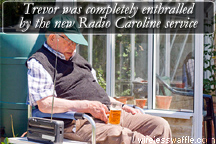 Given that of the neighbouring frequencies, the nearest stations on 639 kHz are in the Czech Republic and Spain (previously crowned the queen of medium-wave broadcasting) and on 657 kHz in Spain (again) and North Wales, it seems unlikely that the additional bandwidth being used by Radio Caroline will give any problems and we are sure that listeners will enjoy the cleaner, brighter sound that they will have on-air.
Given that of the neighbouring frequencies, the nearest stations on 639 kHz are in the Czech Republic and Spain (previously crowned the queen of medium-wave broadcasting) and on 657 kHz in Spain (again) and North Wales, it seems unlikely that the additional bandwidth being used by Radio Caroline will give any problems and we are sure that listeners will enjoy the cleaner, brighter sound that they will have on-air.
Wireless Waffle recently spotted that boat trips to see Radio Caroline's ship, the Ross Revenge, were available to book from their web-site (follow the link) and so it seemed like the perfect opportunity to don an anorak and set sail. On the day of the visit, the weather was beautiful, sunny, 26C and the sea was calm, but it isn't always like that. Boarding the Razorbill 3 , the tender which takes you from the jetty at West Mersea out to the Ross Revenge, it was a pleasure to see so many families taking advantage of the weather to go crabbing. The ride out took about 25 minutes and was a delight in itself with the cool sea air rushing past.
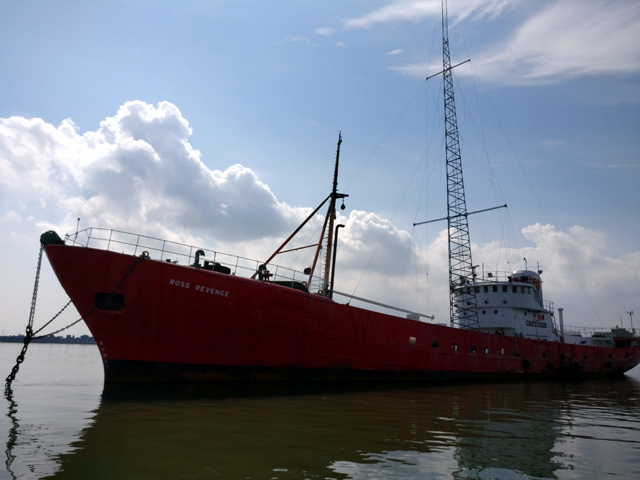 Pulling alongside the boat, it looked exactly as it does in all the postcards, though the current mast is a lot smaller than the 100 metre mast that was in use for transmission during Radio Caroline's heyday. Arrival onto the boat was greeted by a cup of tea and a fig roll in the mess and a description of the history of the boat, which turns out to have been a prize Grimsby-based fishing boat originally made as an Icelandic ice-breaker. Much of the tour of the boat is about the Ross Revenge itself, as well as the catastrophic events of October 1987 which saw the original mast collapse in a storm.
Pulling alongside the boat, it looked exactly as it does in all the postcards, though the current mast is a lot smaller than the 100 metre mast that was in use for transmission during Radio Caroline's heyday. Arrival onto the boat was greeted by a cup of tea and a fig roll in the mess and a description of the history of the boat, which turns out to have been a prize Grimsby-based fishing boat originally made as an Icelandic ice-breaker. Much of the tour of the boat is about the Ross Revenge itself, as well as the catastrophic events of October 1987 which saw the original mast collapse in a storm.
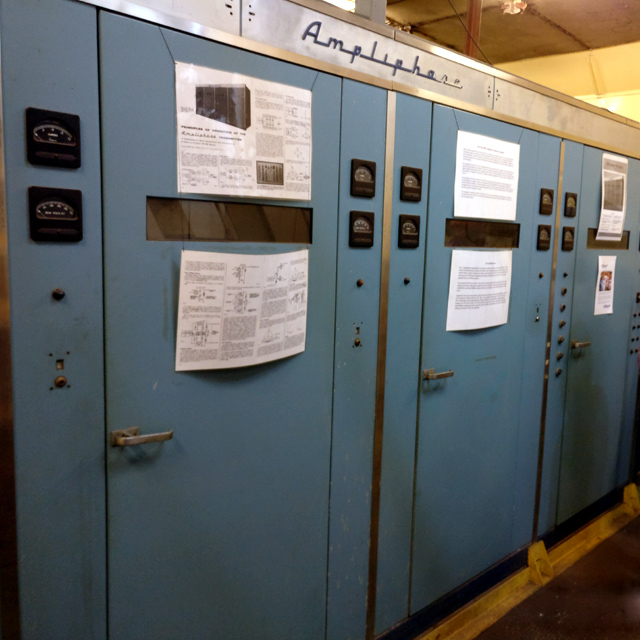 Of course no tour of such an historic ship would be complete without a visit to the studios and the technical facilities such as the engine room, generator room and of course the transmitter room. The 50 kW 'Ampliphase' transmitter consumed nearly 1 tonne of fuel per day to operate so it's no wonder that getting supplies to the boat, including diesel and fresh water, were so critical.
Of course no tour of such an historic ship would be complete without a visit to the studios and the technical facilities such as the engine room, generator room and of course the transmitter room. The 50 kW 'Ampliphase' transmitter consumed nearly 1 tonne of fuel per day to operate so it's no wonder that getting supplies to the boat, including diesel and fresh water, were so critical.
Though the notion of being a pirate at sea may seem romantic, it is clear that the lives of the DJs and other staff must, at times, have been pretty miserable. The cabins below the deck are relatively spartan and if it was blowing a gale, there couldn't have been much to do if you weren't on air.
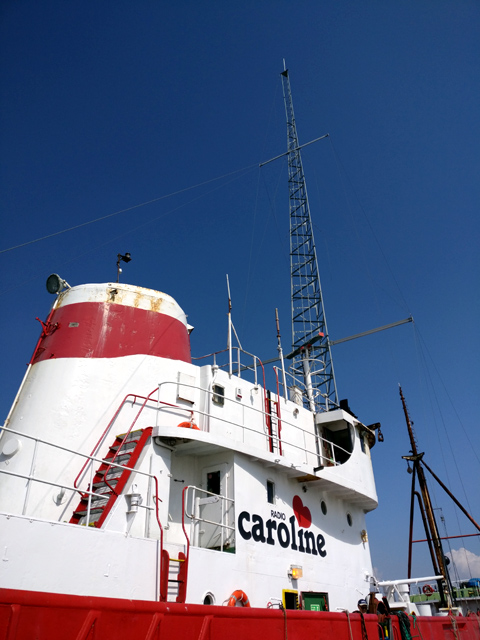 The return from the ship to the shore was equally exhilarating and you left with a lot of respect for those who took to the seas to try and deliver a radio service that filled the gap left by the legal, land-based services.
The return from the ship to the shore was equally exhilarating and you left with a lot of respect for those who took to the seas to try and deliver a radio service that filled the gap left by the legal, land-based services.
The tour comes with the Wireless Waffle 'big thumbs up' seal of approval, and is highly recommended. Obviously the weather can not be guaranteed, but an interesting and enlightening day-out is assured.
Recently, Radio Caroline has been awarded a licence by Ofcom to operate a 1 kW medium wave service on the old BBC World Service channel of 648 kHz. Whether the station can hold its own in today's crowded, on-line, market remains to be seen, but there will no doubt be a few anoraks tuning in for old time's sake. And maybe they can re-capture the spirit of those halcyon days without needing sea sick buckets.
 Pulling alongside the boat, it looked exactly as it does in all the postcards, though the current mast is a lot smaller than the 100 metre mast that was in use for transmission during Radio Caroline's heyday. Arrival onto the boat was greeted by a cup of tea and a fig roll in the mess and a description of the history of the boat, which turns out to have been a prize Grimsby-based fishing boat originally made as an Icelandic ice-breaker. Much of the tour of the boat is about the Ross Revenge itself, as well as the catastrophic events of October 1987 which saw the original mast collapse in a storm.
Pulling alongside the boat, it looked exactly as it does in all the postcards, though the current mast is a lot smaller than the 100 metre mast that was in use for transmission during Radio Caroline's heyday. Arrival onto the boat was greeted by a cup of tea and a fig roll in the mess and a description of the history of the boat, which turns out to have been a prize Grimsby-based fishing boat originally made as an Icelandic ice-breaker. Much of the tour of the boat is about the Ross Revenge itself, as well as the catastrophic events of October 1987 which saw the original mast collapse in a storm.  Of course no tour of such an historic ship would be complete without a visit to the studios and the technical facilities such as the engine room, generator room and of course the transmitter room. The 50 kW 'Ampliphase' transmitter consumed nearly 1 tonne of fuel per day to operate so it's no wonder that getting supplies to the boat, including diesel and fresh water, were so critical.
Of course no tour of such an historic ship would be complete without a visit to the studios and the technical facilities such as the engine room, generator room and of course the transmitter room. The 50 kW 'Ampliphase' transmitter consumed nearly 1 tonne of fuel per day to operate so it's no wonder that getting supplies to the boat, including diesel and fresh water, were so critical.Though the notion of being a pirate at sea may seem romantic, it is clear that the lives of the DJs and other staff must, at times, have been pretty miserable. The cabins below the deck are relatively spartan and if it was blowing a gale, there couldn't have been much to do if you weren't on air.
 The return from the ship to the shore was equally exhilarating and you left with a lot of respect for those who took to the seas to try and deliver a radio service that filled the gap left by the legal, land-based services.
The return from the ship to the shore was equally exhilarating and you left with a lot of respect for those who took to the seas to try and deliver a radio service that filled the gap left by the legal, land-based services.The tour comes with the Wireless Waffle 'big thumbs up' seal of approval, and is highly recommended. Obviously the weather can not be guaranteed, but an interesting and enlightening day-out is assured.
Recently, Radio Caroline has been awarded a licence by Ofcom to operate a 1 kW medium wave service on the old BBC World Service channel of 648 kHz. Whether the station can hold its own in today's crowded, on-line, market remains to be seen, but there will no doubt be a few anoraks tuning in for old time's sake. And maybe they can re-capture the spirit of those halcyon days without needing sea sick buckets.
 No sooner had Wireless Waffle discovered the existence of one medium wave pirate, another one pops up. Paradise FM was being received loud and relatively clear last night on 1440 kHz (now clear of the sadly defunkt 'Great 208') around 21:00 GMT. The web-site gives phone contact numbers in Belgium but it is written in German, and gives details for a town called Mont Rigi which is in the German speaking part of Belgium (you knew German was an official language of Belgium right?)
No sooner had Wireless Waffle discovered the existence of one medium wave pirate, another one pops up. Paradise FM was being received loud and relatively clear last night on 1440 kHz (now clear of the sadly defunkt 'Great 208') around 21:00 GMT. The web-site gives phone contact numbers in Belgium but it is written in German, and gives details for a town called Mont Rigi which is in the German speaking part of Belgium (you knew German was an official language of Belgium right?) Their web-site also declares that the station is on FM and AM Stereo but no frequency for either is given and as the receiver we were using does not decode AM stereo, this possibility could not be confirmed. Also, there is no FM frequency for any station called 'Paradise' listed in that area of Belgium but if it is a pirate, that is to be expected! Nonetheless, perhaps the Belgian/German heritage is valid.
Either way, it seems that the medium wave band is not as dead and boring as we hadn't given it credit for. Long live medium wave!

